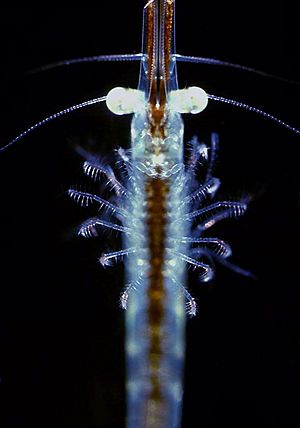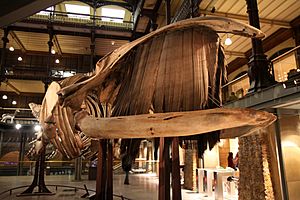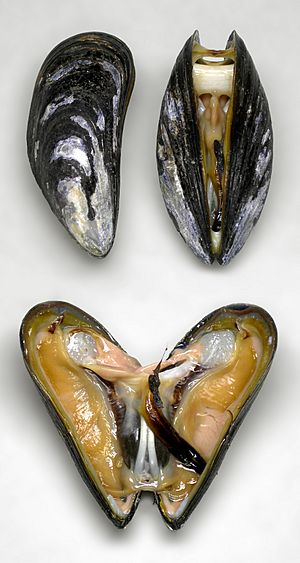Filter feeder facts for kids
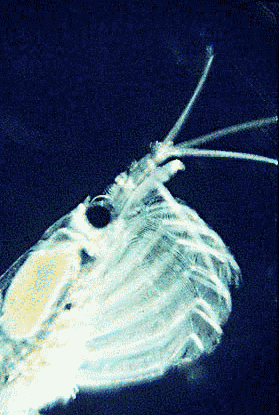
Filter feeders are amazing animals that get their food by straining tiny bits of matter and food particles from water. Imagine a giant sieve! Some common filter feeders include clams, krill, sponges, baleen whales, and many types of fish like some sharks. Even some birds, such as flamingos, are filter feeders. These animals play a super important role in keeping water clean.
Contents
Fish that Filter Feed
Many forage fish, which are small fish often eaten by larger ones, are filter feeders. For example, the Atlantic menhaden, a type of herring, catches plankton in the middle of the ocean. Adult menhaden can filter a lot of water every minute, helping to clear up ocean water. They also help control harmful red tides.
Besides bony fish, four kinds of cartilaginous fishes (fish with skeletons made of cartilage, not bone) are also filter feeders.
- The whale shark takes in a huge mouthful of water. It then closes its mouth and pushes the water out through its gills. Tiny plankton get caught on special sieve-like structures inside its gills. Anything bigger than a few millimeters gets trapped and swallowed. Whale sharks sometimes "cough" to clear their filters.
- The megamouth shark has special glowing organs around its mouth called photophores. Scientists think these might attract plankton or small fish for it to eat.
- The basking shark is a "passive" filter feeder. It swims with its mouth open, letting water flow through its gills to catch zooplankton (tiny animals), small fish, and invertebrates. Unlike the whale shark or megamouth shark, it doesn't suck or pump water; it just relies on swimming.
- Manta rays are clever! They can time their feeding to when large groups of fish are laying eggs and sperm, and then they eat these floating bits. Whale sharks do this too.
Crustaceans that Filter Feed
Mysidacea are small crustaceans that live near the shore. They float above the seafloor, constantly using their "filter basket" to collect tiny particles. They are a key food source for many fish, including herring, cod, and flounder. Mysids can handle pollution well, which means they might pass toxins to the animals that eat them.
Antarctic krill are amazing because they can directly eat tiny phytoplankton cells. Most other animals their size can't do this. Krill use their front legs, which form a very effective "feeding basket," to collect phytoplankton from the water. When there isn't much food, they push their feeding basket through the water for a long distance, then comb the algae into their mouths.
Porcelain crabs have special feeding parts covered with tiny hairs called setae. These hairs help them filter food particles from the water as it flows by.
Most types of barnacles are filter feeders. They use their changed legs to sift plankton from the water.
Baleen Whales
Baleen whales are a group of whales that have baleen plates instead of teeth. These plates are used to filter food from the water. This is how they are different from toothed whales. There are fourteen different species of baleen whales.
Baleen whales usually find a lot of zooplankton (tiny animals). They swim through it, either with their mouths open or by taking big gulps, and then filter the prey from the water using their baleen. Baleen is made of a material similar to your hair or fingernails. These plates have fine hairs that form a filtering mat.
- Right whales swim slowly and have large heads and mouths. Their baleen plates are very long, up to 4 meters in bowheads. As they swim, water and prey enter a gap in the front of their baleen, and the baleen filters the water out.
- Rorquals, like the blue whale, are fast swimmers with shorter, wider baleen plates. To catch food, they open their lower jaw very wide, almost 90 degrees. They swim through a swarm of prey, taking in huge amounts of water.
Baleen whales mostly eat krill in cold waters during the summer. They can also eat schooling fish, especially in the Northern Hemisphere. Most baleen whales feed near the surface, but gray whales live in shallow waters and mostly eat organisms that live on the bottom, like amphipods.
Bivalves
Bivalves are water-dwelling molluscs that have shells made of two parts. These shells are usually symmetrical. There are about 30,000 species of bivalves, including scallops, clams, oysters, and mussels. Most bivalves are filter feeders. They get organic matter from the water they live in. They have special organs, like kidneys, called nephridia, to remove waste.
Bivalves that live buried in the sand extend a tube-like siphon to the surface to feed. For example, oysters pull water over their gills using tiny hairs called cilia. Food like phytoplankton, zooplankton, algae, and other particles in the water get trapped in the mucus on their gills. From there, the food goes to their mouth, is eaten, digested, and then waste is expelled. Each oyster can filter up to five liters of water per hour!
Scientists believe that the huge oyster population in Chesapeake Bay used to filter all the water in the bay every few days. Now, it takes almost a year, which leads to problems with too much sediment, nutrients, and algae. Oysters help by filtering these pollutants and either eating them or turning them into harmless packets that sink to the bottom.
Bivalve shellfish also help recycle nutrients that enter waterways from farms and human activities. They are often used as bioindicators to check how healthy a water environment is.
Sponges
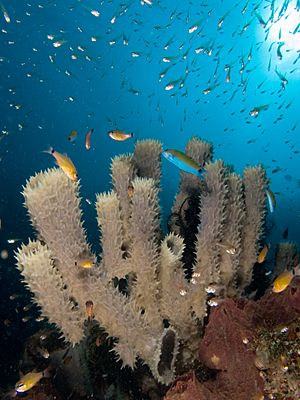
Sponges don't have a true blood system. Instead, they create a water current that helps them move things around their bodies. Gases like oxygen enter their cells directly from the water. Waste products also leave their cells into the water.
Sponges can pump an amazing amount of water. For example, a small sponge called Leuconia (about 10 cm tall) has over 80,000 tiny canals where water enters. This water then flows slowly through millions of tiny chambers where food is captured by special cells. Finally, the water is shot out through a single opening at a fast speed, carrying waste far away from the sponge.
Cnidarians
The moon jellyfish has a network of fibers that it slowly pulls through the water. This movement is so slow that tiny crustaceans called copepods don't even notice it and don't try to escape.
-
A live Aurelia jellyfish in the Baltic Sea showing its feeding fibers.
Other cnidarians that filter feed include sea pens, sea fans, plumose anemones, and Xenia.
Flamingos
Flamingos filter-feed on tiny creatures like brine shrimp. Their strangely shaped beaks are specially designed to separate mud and dirt from their food. They even use their beaks upside-down! To help filter food, they have hairy structures called lamellae inside their beaks and a large, rough tongue.
Pterosaurs
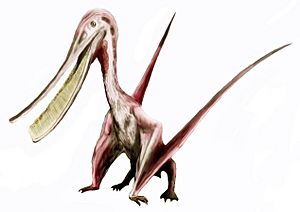
Some ancient flying reptiles called ctenochasmatoids were thought to be filter feeders because of their many long, thin teeth. However, only one, Pterodaustro, seems to have had the right mouth parts to pump water and filter food. It had jaws that curved upwards and strong jaw and tongue muscles. Other ctenochasmatoids probably used their teeth more like a spoonbill to catch prey, rather than filtering.
Another group, Boreopterids, might have done a simple kind of filter feeding. They used their long, thin teeth to trap small fish, but probably didn't pump water like Pterodaustro. Their feeding was similar to how young river dolphins hunt today.
Marine Reptiles
Filter feeding was not very common among Mesozoic marine reptiles (ancient reptiles that lived in the sea). However, some reptiles are thought to have been filter feeders. Henodus was a placodont (a type of marine reptile) with unique baleen-like teeth and jaw muscles similar to flamingos. Since it lived in a lake environment, it might have had a similar lifestyle, possibly filtering algae and other small plants from the bottom.
The Stomatosuchidae family of freshwater crocodylomorphs (relatives of crocodiles) had jaws like rorqual whales and tiny teeth. Another unrelated ancient crocodile relative, Mourasuchus, had similar features.
Hupehsuchia is a group of strange Triassic reptiles that were adapted for suspension feeding (another term for filter feeding).
Some plesiosaurs (long-necked marine reptiles) might also have been filter feeders.
Images for kids
See also
 In Spanish: Alimentación por filtración para niños
In Spanish: Alimentación por filtración para niños



